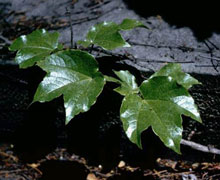


Home
Flowers &
Indoor Plants
Fruits & Nuts
Ornamentals
Vegetables
Special Topics
Resources
Glossary

Boston Ivy |
 |
What about it? This plant is native to Japan and China, which explains why it also called Japanese ivy. It is named Boston ivy because it decorates many of the buildings in that city. It is also one of the ivies that climb the old walls of buildings of colleges in the "Ivy League". Boston ivy is a deciduous vine with very glossy green, three-lobed leaves. It climbs up walls and fences by means of tendrils, or small spiralling "arms", and adhesive discs. There are a few popular varieties: "Lowii" has small leaves (1" long) that are purple when the plant is young; "Purpurea" has leaves that are purple throughout the summer; and "Veitchii" that has larger, purplish leaves (1-2 inches). What is it used for? Boston ivy makes a handsome green summer foliage that will turn a showy reddish-purple in the fall. It can be used as a decoration or as a barrier. It also comes in handy to cover up less-thandesirable exterior designs. Where does it grow? How do we grow it? Boston ivy does well in fertile, moist but well-drained soil. Central New York is about as far north as this plant can tolerate. It prefers a milder climate. Watch out: if given the space and the opportunity it will extend itself up to 50 feet. When planting they should be spaced 15 feet from anything you don't want to be covered in a few years. What are its primary problems? Boston ivy is quite a vigorous grower and it can easily take over a building in a short while. Also, don't grow near painted surfaces for it's adhesive chemicals will destroy the paint. Guignardia, leaf spot is common and causes disfiguring. Japanese beetles, scale insects, and mites can attack Boston Ivy.
© Copyright, Department of Horticulture, Cornell University. |


